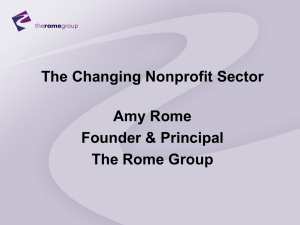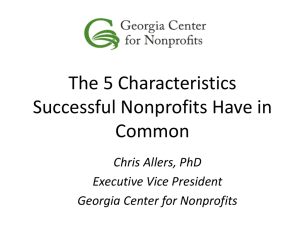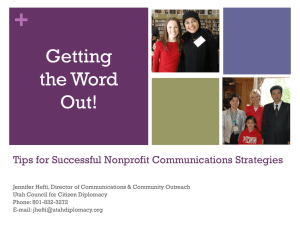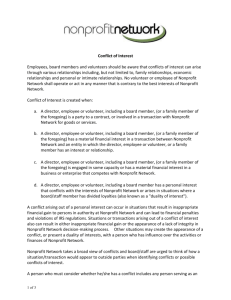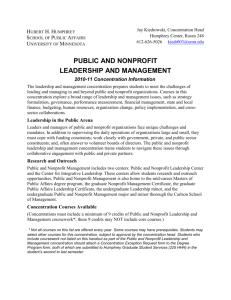Rebekah McCloud Leadership–It`s in the Application
advertisement
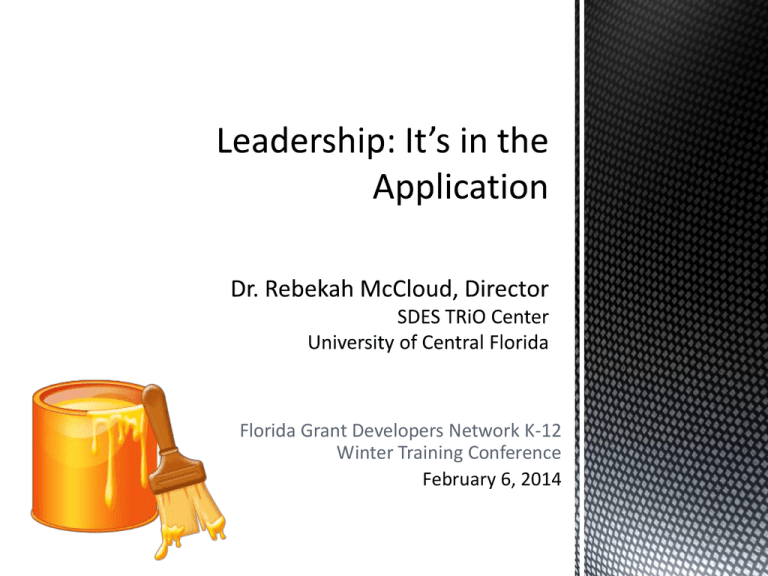
Florida Grant Developers Network K-12 Winter Training Conference February 6, 2014 As a result of this session, participants be introduced to: Definition of Leadership How to Adapt Leadership Styles Leadership Growth What Leaders Really Do Management vs. Leadership 10 Rules of Good Followership Issue Facing Non-Profit Organizations How can Issues be Addressed? Issues Facing Non-Profit Leaders How can Issues be Addressed? “Leadership is like a can of paint…it’s value is in the application” --Unknown Think-Pair-Share (Handout #1) Think about painting a house. What are the characteristics of: A poor job An ok job A good job An excellent job Take 2 minutes to write something down on the handout provided Pair-Share: Take two minutes (one each) to share with a partner As we go through this training session, asses yourself on the various topics. Peter Drucker: “The only definition of a leader is someone who has followers.” Warren Bennis: “Leadership is the capacity to translate vision into reality.” Bill Gates: “As we look ahead into the next century, leaders will be those who empower others.” John Maxwell: “Leadership is influence – nothing more, nothing less.” DEFINITION: Leadership is a process of social influence, which maximizes the efforts of others, towards the achievement of a goal. Source: Keven Kruse, What is Leadership, Forbes at http://www.forbes.com/sites/kevinkruse/2013/04/09/w hat-is-leadership/ Many theories of management and styles of leadership exist. In the end, none of them are right and none of them are wrong. Different people respond better to different styles of leadership. To be a truly skilled leader, become aware of the needs of your staff and adapt your leadership style to nurture the most productivity in your workers. Follow these four easy steps… Step 3. Appreciate the diversity among your staff. Workers with more skill will most likely respond well to democratic and laissez-faire leadership styles; those with less experience will likely respond more to a more autocratic style. Step 4. Experiment with different styles to see what works best with your group of workers. Maintain an "open door" policy so that workers can approach you to discuss workrelated issues. As you get to know your workers, you will get a sense of how much direction and how much freedom they need to be productive. Steps 1-4 Adapted from Samantha Hanly, Houston Chronicle, http://smallbusiness.chron.com/adapt-leadership-styles-18975.html Leadership develops daily, not in a day What matters Most is what you do day by day over the long haul The ability to lead is a collection of skills, nearly all of which can be learned and improved It is the capacity to develop and improve their skills that distinguishes leaders from followers Four Phases of leadership growth: I don’t know what I don’t know I know what I don’t know I grow and know and it starts to show I simply go because of what I know Source: John Maxwell (The 21 Irrefutable Laws of Leadership) Leaders decide what needs to be done, create networks of people to accomplish the agenda, and ensure that the work actually gets done.* Sets the vision of an organization Vision—A vision statement includes a complete description of you sometime in the future after your goal has already been successfully accomplished. Establishes the mission Mission—A mission statement describes your overall purpose. It is detailed and speaks to who you are and what you will need to do to make your vision a reality. * Adapted from John Kotter, What Leaders Really Do, Harvard Business Review, http://www.faithformationlearningexchange.net/uploa ds/5/2/4/6/5246709/what_leaders_really_do.pdf Develops Goals* Goals—A goal is the purpose toward which an endeavor is directed. Goals may not be strictly measurable or tangible. Maps out objectives* Objectives—An objective is something that one's efforts or actions are intended to attain or accomplish; purpose; target. Must be measurable and tangible (SMART). Empowers staff to go forth and do** Delegate tasks clearly and concisely Acknowledge employee achievements Open your door to employees Coach employees to be all they can be Promote employee education Give up some of your power in favor of employee autonomy Invite feedback from your employees Be willing to do what you ask them to do Evaluate Yourself *Source: Adapted from Goal vs Objective, http://www.diffen.com/difference/Goal_vs_Objective **Adapted from How to Empower Employees at http://www.wikihow.com/Empower-Employees 1. Planning and budgeting versus setting direction The aim of management is predictability— orderly results Leadership’s function is to produce change. Setting the direction of change is essential work. 2. Organizing and staffing versus aligning people Managers look for the right fit between people and jobs Leaders look for the right fit between people and the vision. 3. Controlling activities and solving problems versus motivating and inspiring Management strives to make it easy for people to complete routine jobs day after day. Leaders attempt to touch people at their deepest levels—by stirring in them a sense of belonging, idealism, and self-esteem. Adapted from John Kotter, What Leaders Really Do, Harvard Business Review, http://www.faithformationlearningexchange.net/up loads/5/2/4/6/5246709/what_leaders_really_do.pd f 10 Rules of Good Followership (Handout #2) 1. Don’t blame your boss for an unpopular decision or policy; your job is to support, not undermine. 2. Fight with your boss if necessary; but do it in private, avoid embarrassing situations, and never reveal to others what was discussed 3.Make the decision, then run it pass the boss; use your initiative. 4. Accept responsibility whenever it is offered. 5. Tell the truth and don’t quibble; your boss will be giving advice up the chain of command based on what you said. 6. Do your homework; give your boss all the information needed to make a decision; anticipate questions. 7. When making a recommendation, remember who will probably have to implement it. This means you know your own limitations and weaknesses as well as your strengths. 8. Keep your boss informed of what’s going on in the unit; people will be reluctant to tell him or her their problems and successes. You should do it for them, and assume someone else will tell your boss about yours. 9. If you see a problem, fix it. Don’t worry about who would have gotten blame or who gets the praise. 10. Put in more than an honest day’s work, but don’t ever forget the needs of your family’ If they are unhappy, you will be too, and your job performance will suffer accordingly. Evaluate Yourself Economic Unrest* Leadership Succession* Change Management* Learning Gap *Source: Center for Creative Leadership at http://www.leadingeffectively.com/top-three-issuesfacing-nonprofit-organizations-in-2012-2/ Economic Unrest The loss of funding created a huge resource problem for the nonprofit sector and increased the need for services. More nonprofit organizations now compete for fewer dollars. Funders and donors question their own decisions on why they should give to a particular nonprofit organization. It has become more crucial for a nonprofit to state why they acquire their funds and how they use those dollars. This new environment is pushing nonprofit organizations to be more accountable. Economic Unrest Create and stick to a budget Tie your budget to your mission and strategic plan Advance your understanding of nonprofit financial sustainability Learn to write grants Create a development plan for your organization Write a sustainability strategic plan Do a SWOT Analysis (Handout #4) Evaluate Yourself SWOT Analysis (Handout #3) Strengths Weaknesses Opportunities Threats SWOT Analysis is a useful technique for understanding your Strengths and Weaknesses, and for identifying both the Opportunities open to you and the Threats you face. Used in a business context, a SWOT Analysis helps you carve a sustainable niche in your market. Source: SWOT Analysis, Mind Tools at http://www.mindtools.com/pages/article/newTMC _05.htm#sthash.jwfesYyj.dpuf Strategic vs. Tactical Planning Strategic planning is an organization’s process of defining its strategy, or direction, and making decisions on allocating its resources to pursue this strategy. In order to determine the future direction of the organization, it is necessary to understand its current position and the possible avenues through which it can pursue particular courses of action. Generally, strategic planning deals with at least one of three key questions: "What do we do?" "For whom do we do it?" "How do we excel?" Many organizations view strategic planning as a process for determining where an organization is going over the next year or—more typically—3 to 5 years (long term), although some extend their vision to 20 years Source: Strategic Planning at http://en.wikipedia.org/wiki/Strategic_planning Strategic vs. Tactical Planning Tactical Planning is Short range planning that emphasizes the current operations of various parts of the organization. Short Range is defined as a period of time extending about one year or less in the future. Managers use tactical planning to outline what the various parts of the organization must do for the organization to be successful at some point one year or less into the future. Tactical plans are usually developed in the areas of production, marketing, personnel, finance and plant facilities. Source: Tactical vs Strategic Planning at http://managementinnovations.wordpress.com/20 08/12/10/tactical-planning-vs-strategic-planning/ Leadership Succession There is a leadership capacity deficit in the nonprofit sector. The nonprofit sector has wonderful leaders and passionately participate in their organization Some leaders find it difficult to guide their organization’s strategic plan Some organizations may not have a succession plan in place. Leadership seats in many organizations are currently occupied, but a retirement or a quick departure from the organization could leave the organization empty-handed Leadership Succession Develop a leadership succession plan/sustainability Make the plan known to all; perhaps add it to your constitution and/or by-laws Grow your own leaders Expand and diversify the professional development options available to staff Create good followers Evaluate Yourself “When the infrastructure shifts, everything rumbles.”—Stan Davis Change Management/Transition Nonprofit leaders are tasked with Managing change Being creative with their resources Using volunteers Selecting board members who can contribute in multiple ways Retaining and hiring the appropriate staff Face multiple changes at the same time. A change in mindset and a change in behavior are the keys to meeting the demands of a nonprofit organization Change Management/Transition Plan for change Embrace change Empower your staff/volunteers to deal with change Make sure everybody is on the same page Create an Elevator Speech Evaluate Yourself Elevator Speech (Handout #4): It should grab attention and say a lot in a few words. It should be 15-30 seconds long and should use action words. Your elevator speech should have the general form: “We do (nature of service) for (ideal client) so that they can (benefit to the client)". Consider including a compelling "hook," an intriguing aspect that will engage the listener. Incorporate examples and stories to help support your points. (STAR— situation or task, action, result). Stories make your speech memorable. Knowing what fire to put out first Knowing your leadership blind spot How to build strategic alliances Developing Next Generation Leadership Diversity Source: Council of Nonprofit at http://www.councilofnonprofits.org/resources/resource s-topic/leadership Knowing what fire to put out first Prioritizing is about making choices of what to do and what not to do. To prioritize effectively you need to be able to recognize what is important, as well as to see the difference between urgent and important. The important, or high priority, tasks are the tasks that help us achieve our longterm goals At first glance, many of the tasks we face during a day seem equally urgent and important. Yet, if you take a closer look, you will see that many of the urgent activities we are involved are not really important in the long run. With good prioritizing skills, you finish as soon as possible all the important urgent tasks. Then, you can focus your attention to those most important, but not urgent tasks. Source: Prioritizing Effectively at http://www.timemanagement-guide.com/prioritizing.html Knowing your leadership blind spot “See ourselves as others see us,” --poet Robert Burns Make sure you are getting feedback; without it, you can overestimate your organizations’ capacity and neglect areas that need improvement. Five categories essential for organizational effectiveness: leadership, decision making and structure, people, work processes, and systems and culture. Areas to ponder: the degree to which an organization’s vision is compelling; clarity about the organization’s impact; and the extent to which an organization’s culture inspires staff and contributes to strong performance. the extent to which an organization clearly communicates its priorities; the degree to which decision roles and processes are well understood; and the degree to which an organization can implement change Humankind has not woven the web of life. We are but one thread within it. Whatever we do to the web, we do to ourselves. All things are bound together. All things connect. —Chief Seattle, 1854 How to build strategic alliances Business Card Work a Room Elevator Speech The most important goals and resulting benefits of strategic alliances are: Increased services Increased programmatic collaborations. Increased market share/competitiveness Increased funding Increase Source: Advanccing Together: The Role of the Nonprofit Board in Successful Strategic Alliances at http://firstnonprofit.org/images/uploads/pdf/Strategic_Allia nces.pdf Developing Next Generation Leadership Rotate people through different jobs. You want to give participants first-hand experience in many different roles throughout your company. Challenge them with unfamiliar jobs. Stretch assignments are growth-oriented exercises with some inherent risk. They’re designed to push participants past their skill level. Create mentoring programs. Typically, employees are paired with more senior employees at their company, though some programs match employees with mentors at other firms. Create clear guidelines for the relationship. Ensure participants get frequent feedback and coaching. You want them to stretch but not break, so make sure they have adequate support in new assignments. Frequent evaluations will help you catch and address problems early on. Tap veterans’ advice. Don’t let older workers’ knowledge walk out the door when they retire. Set up mentoring programs between veterans and high-potential future leaders. Allow participants to wash out. Not every candidate will have what it takes to be a good leader. Restock the program as needed and go outside the company if necessary to seed the program. Source: How to Develop Future Leaders at http://guides.wsj.com/management /managing-your-people/how-todevelop-future-leaders/ “Diversity is generally defined as acknowledging, understanding, accepting, valuing, and celebrating differences among people with respect to age, class, ethnicity, gender, physical and mental ability, race, sexual orientation, spiritual practice, and public assistance status.”* A diverse workforce is a reflection of a changing world and marketplace. Diverse work teams bring high value to organizations. Respecting individual differences will benefit the workplace by creating a competitive edge and increasing work productivity. Provide and participate in diversity training Identify specific issues around diversity in your organization * Source: Esty, Katharine, Richard Griffin, and Marcie Schorr-Hirsh (1995). Workplace diversity. A managers guide to solving problems and turning diversity into a competitive advantage. Avon, MA: Adams Media Corporation. Today we talked about: Definition of Leadership How to Adapt Leadership Styles Leadership Growth What Leaders Really Do Management vs. Leadership 10 Rules of Good Followership Issue Facing Non-Profit Organizations How can Issues be Addressed? Issues Facing Leaders How can Issues be Addressed? Recap of the day Know your stuff Get a terminal degree Get your hands dirty Walk the Dog Toot Your Own Horn Be a straw, not a cup Get wisdom, discipline and understanding (Proverbs 23:23) Give back Questions Contact Me: Dr. Rebekah McCloud University of Central Florida P.O. Box 161920 Orlando, FL 32816-1920 407-823-0344 Rebekah.mccloud@ucf.edu Q&A Contact Me

